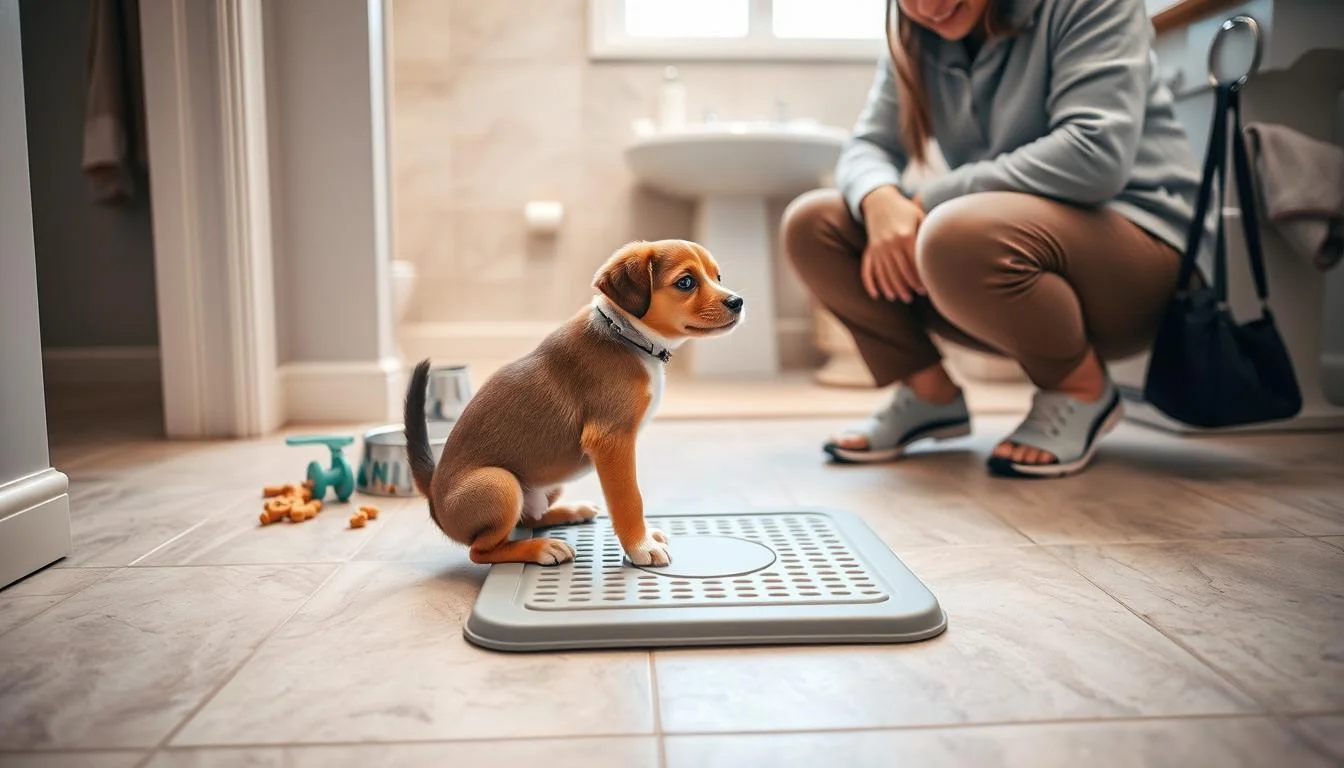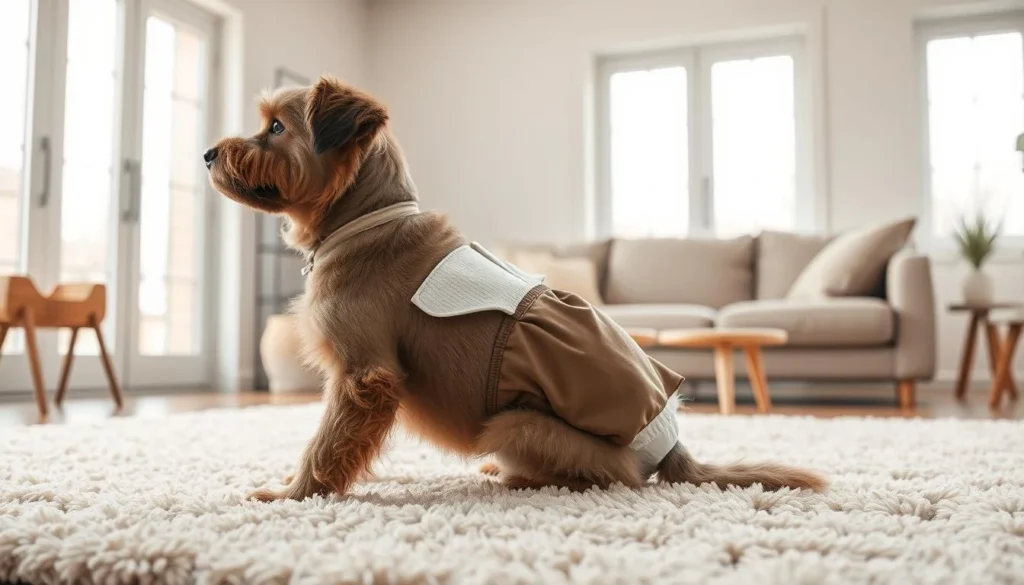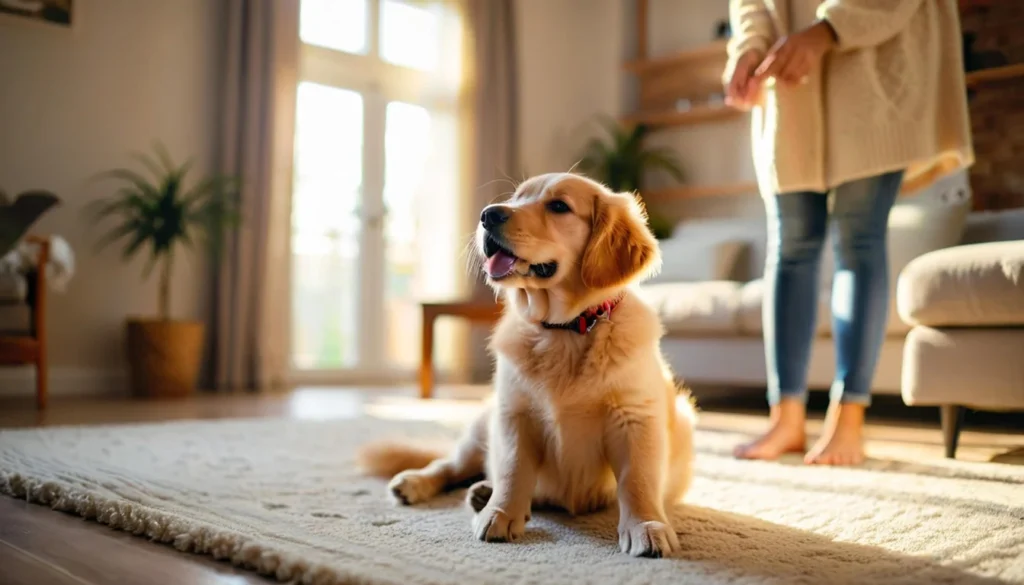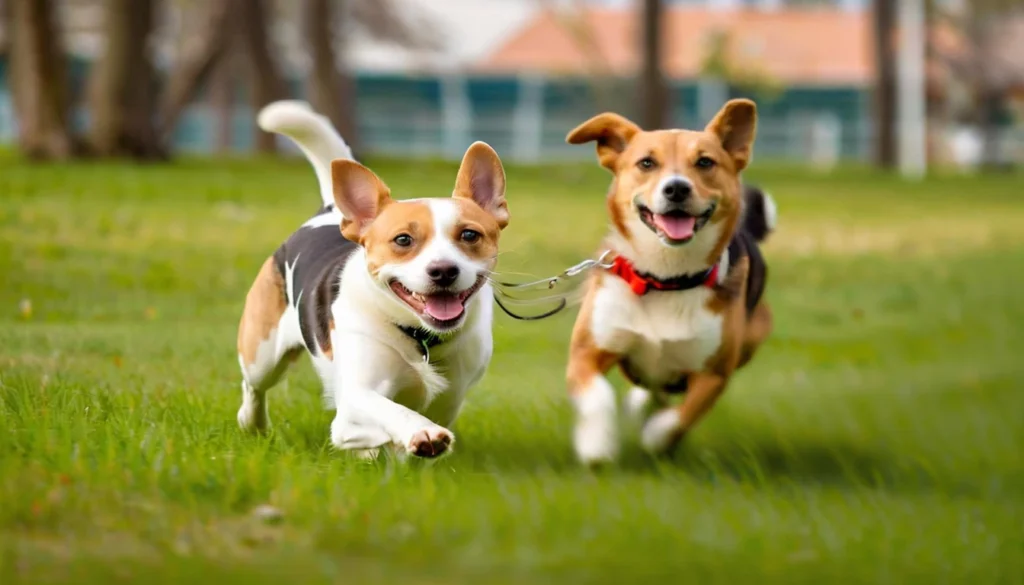I remember the first week with my Labrador mix: excitement and tiny paws. I quickly learned that potty training needs a plan, not luck. A clear plan makes the journey less stressful for both of you.
This page aims to help you start housebreaking right away. Potty training is key for good behavior, a clean home, and a strong bond with your dog. We'll discuss crate training, puppy pads, outdoor methods, schedules, and more.
Before your puppy arrives, research and choose a method that suits you. Get the right supplies: a crate, cleaner, treats, leash, and indoor potty options. Stay consistent and patient, and you'll see how planning and rewards can train your puppy fast.
Key Takeaways
- Plan before bringing your puppy home to avoid early confusion.
- Assemble essential supplies: crate, enzymatic cleaner, treats, and potty options.
- Choose a method that fits your lifestyle—crate, pads, or outdoor-only.
- Consistency and a clear schedule speed up progress toward the best way to potty train puppy fast.
- Positive reinforcement and reading signals build trust and reliable habits.
Why potty training matters for a happy puppy and home
I see housetraining as a key to a puppy's success. A clean home reduces stress for everyone. It also stops bad smells, protects floors and furniture, and makes training easier as the dog grows.
Long-term benefits of early housetraining
Start early to avoid rehoming due to bad behavior. A well-trained puppy saves time and money on repairs and vet visits. Early training makes future lessons easier, from walking on a leash to vet visits.
How potty training builds routine, confidence, and trust
Regular trips outside teach control and clear expectations. I use short, calm walks and praise for good behavior. This routine strengthens our bond and boosts a puppy's confidence in new places.
When to start: developmental milestones and ideal timing
I start training the moment a puppy arrives. An eight-week-old needs more breaks than a five-month-old. Use the age-in-months rule for holding times, but remember each puppy is different.
I focus on housetraining first, not tricks. Plan regular outings, research methods, and stick to a schedule for fast results. For nighttime success, plan short checks and quiet wake-ups.
Understanding proven potty training methods and choosing what works
I explain three common potty training methods. Each has its own steps, tools, and trade-offs. I share how crate training, puppy pads, and outdoor-only routines work. I also talk about when it's safe to mix them.
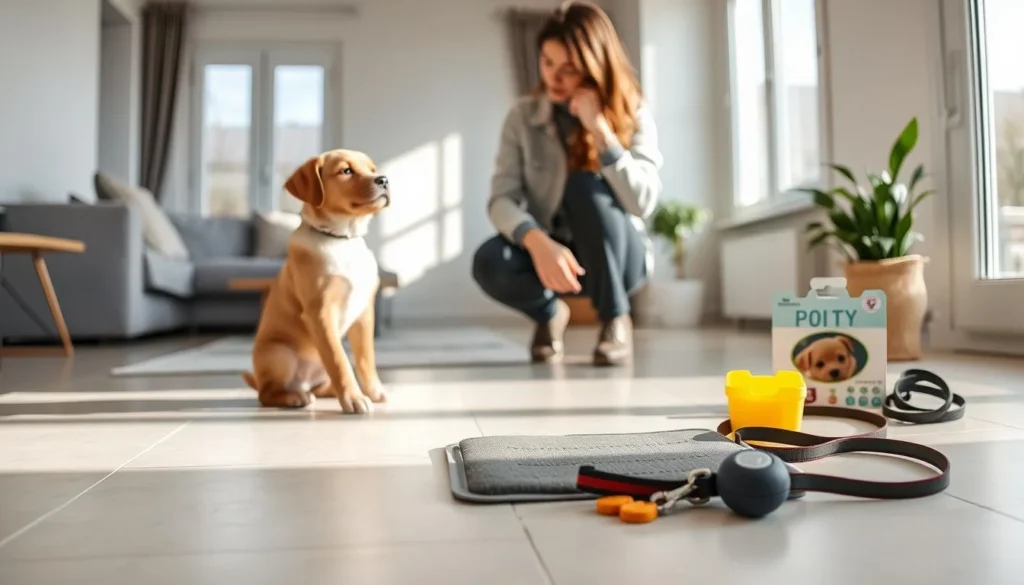
Overview of crate training, paper/puppy pads, and outdoor-only methods
Crate training uses a puppy’s den instinct to reduce accidents. I use the right-size crate and introduce it slowly. Puppies learn to hold when they have a comfortable, secure space.
Puppy pads give a designated indoor spot. They're useful when outdoor access is limited or weather is severe. They help transition to outdoor toileting with a plan.
Outdoor-only means a single, consistent spot and a cue phrase. I recommend frequent trips so the puppy links the cue with elimination outdoors.
Pros and cons of each method based on lifestyle
For apartments, the best way to potty train a puppy often combines pads and a crate. Pads cut down on stair trips. The downside is a longer outdoor transition if pads become the permanent habit.
When it’s cold, the best way to potty train a puppy in the winter may start with indoor options. I layer protection and move the puppy to outside areas gradually once conditions improve.
If you work outside the home, the best way to potty train puppy while working full time usually mixes crate use with midday help from a walker or sitter. Pads can be a practical stopgap. Long-term reliance on pads can slow outdoor training unless you plan a staged change.
How to combine methods safely to avoid confusion
I always keep cues and rewards consistent across locations. If I use pads and plan to move outdoors, I shift pads closer to the door each day until they sit on the porch, then outside.
Crate training serves as my anchor during transitions. I avoid mixed messages like allowing random indoor eliminations while sometimes taking the pup out for the same behavior.
| Method | Best for | Main advantage | Common drawback |
|---|---|---|---|
| Crate training | Anyone wanting structure | Teaches bladder control and prevents accidents | Needs correct size and gentle introduction |
| Puppy pads / indoor potty | Apartments, winter, full-time workers | Provides a reliable indoor spot when outdoor trips are hard | Can delay outdoor-only habits without a transition plan |
| Outdoor-only | Homes with easy outdoor access | Fastest route to outdoor elimination with frequent outings | Requires time and consistent access throughout the day |
Crate training as a primary tool for housebreaking
I use a crate as my first line of defense when teaching a puppy where to go. Crates tap into a dog’s den instinct and limit access so the pup cannot roam and have accidents. This method works well whether I aim for the best way to potty train puppy at home or need the best way to potty train puppy in apartment living.
Crates prevent accidents by making a small, safe space where puppies usually refuse to soil their sleeping area. They also simplify travel and vet visits by keeping the dog calm in a familiar spot. For those who want the best way to potty train a puppy fast, consistent crate use shortens confusion and speeds learning.
Choosing the right size
I pick a crate that lets my puppy stand, turn, and lie down without extra room to relieve itself far from the bedding. A crate that is too big can allow a pup to eliminate in one corner and sleep in another, which defeats training. I use dividers to adjust the usable space as the puppy grows. Dividers let me use a single crate from tiny puppy to adolescent dog while keeping the den appropriately sized.
Introducing the crate
My first step is making the crate welcoming. I add a soft bed, a durable chew toy, and place meals near or inside the crate so my puppy sees it as a positive zone. I reward calm behavior with small treats and praise. I never use the crate as punishment. If a puppy associates the crate with negative experiences, I go back to basics and rebuild trust with short, pleasant sessions.
Time limits and troubleshooting
I follow the age-in-months rule for safe crate time and never leave very young puppies crated for long stretches. Puppies often cannot hold their bladder beyond a few hours. I give frequent breaks for water, supervised play, and bathroom trips. If soiling occurs in the crate, I reassess the schedule, check feeding times, and consult my vet for medical issues. I clean the crate with an enzymatic cleaner so the puppy won't be drawn back to the same spot.
| Topic | Practical Tip | Why it Helps |
|---|---|---|
| Crate Size & Dividers | Choose a crate that fits current size; use dividers to limit space | Prevents sleeping area soiling and adapts as the puppy grows |
| Positive Association | Feed near or inside crate; add bedding and toys; reward calm entry | Makes crate a safe, inviting den rather than a place of fear |
| Time Limits | Follow age-in-months guideline; provide regular breaks | Protects health and avoids accidents from over-crating |
| Accident Response | Adjust schedule, review diet, clean with enzymatic products | Fixes location repeats and rules out medical causes |
| Apartment Use | Place crate near living area; keep outings regular and brief | Supports the best way to potty train puppy in apartment settings |
| Speeding Results | Combine crate with timed outdoor trips and rewards | Helps achieve the best way to potty train a puppy fast |
Creating a consistent potty training schedule that works fast
I create a routine the moment a puppy arrives. A consistent plan cuts down on accidents and speeds up learning. I use a simple rule based on the puppy's age to determine holding times and outings.
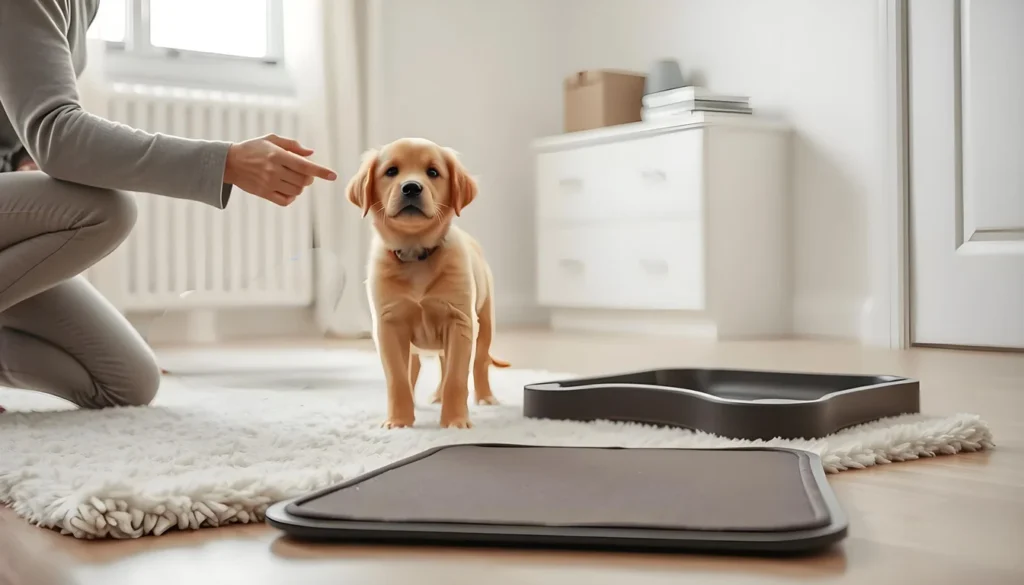
Using age-in-months guideline to set safe holding times
A puppy can hold urine for about its age in months. For instance, a 4-month-old can usually hold for four hours. Young puppies can't hold for 10–12 hours, so I adjust intervals based on their size and control.
When to take puppies out: first thing, after naps, play, meals, and before bed
I take the puppy out at set times. This includes first thing in the morning and last thing at night. I also take them out after naps, play, meals, and before bed.
I always let the puppy out before and after crate time. I use the same door, spot, and cue phrase. This helps the puppy connect the routine to the action, making potty training faster.
How I track progress and adjust the schedule for faster results
I keep a log of potty times and accidents. This log helps me spot patterns and adjust intervals. If accidents increase, I shorten the gaps and review food and water timing.
For quicker results, I focus on the outing. I avoid distractions, use the same cue, and reward immediately. If unsure, I err on the side of caution and take the puppy out. This approach shows my belief in frequent, consistent reinforcement for faster learning.
Recognizing potty signals and preventing accidents
I keep a close eye on my puppy for signs they need to go. Learning these cues is key to successful potty training.
Signs include sniffing, circling, whining, pacing, or scratching at doors. Restlessness or stopping play means it's time for a bathroom break.
In big homes, I limit my puppy's freedom. I use baby gates, leashes, or small playpens to keep them close. This helps me catch any signs of needing to go.
In apartments, I stay close to my puppy and set regular bathroom breaks. For backyards, I create a routine that makes going outside a habit.
If I see my puppy starting to go inside, I interrupt calmly. I take them outside to the same spot. If they finish outside, I reward them with praise and treats.
If I find an accident inside, I don't scold. I clean the area with a special cleaner. Then, I watch them more closely and take them out more often.
Preventing accidents means being proactive. I take my puppy out in the morning, after naps, play, and before bed. This schedule, along with watching for signs, helps potty train my puppy fast.
| Situation | Immediate Action | Prevention Tip |
|---|---|---|
| Puppy sniffing and circling | Interrupt gently, carry outside to spot | Increase frequency of outdoor trips after meals |
| Whining or pacing near door | Open door, leash up, guide to potty area | Establish a door-to-spot routine with a cue phrase |
| Accident found later | Do not scold; clean with enzymatic cleaner | Tighten supervision and shorten free-roam time |
| Large home with many rooms | Use baby gates or tether to keep puppy near me | Confine to a smaller supervised area until trained |
| Goal: outdoor-only elimination | Carry puppy to the same outdoor spot after interruption | Consistent rewards for finishing outside reinforce behavior |
Positive reinforcement techniques to encourage outdoor elimination
I reward my puppy the moment they finish outside. This timing is key to creating a good habit. A calm "good job" and a small treat right after helps them learn where to go.
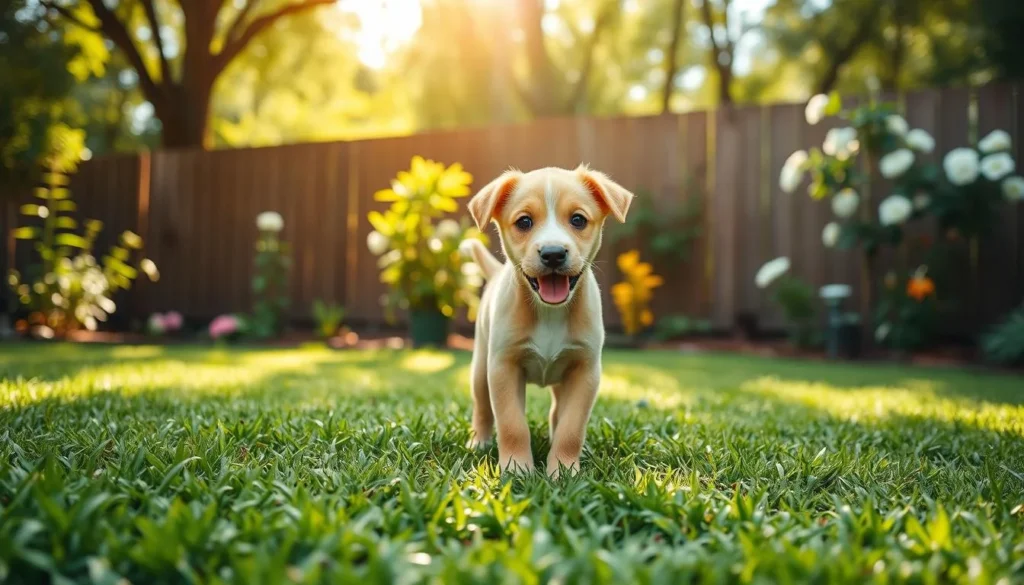
Using consistent cues and a routine helps my puppy learn fast. Saying a short phrase when they're about to go helps them learn to go on command. This is a crucial part of potty training.
I choose soft, small treats like cooked chicken or training treats. I keep the celebration calm while they finish, then give the treat. This calm approach is why many find it better than loud cheering.
I avoid play until the job is done. Bringing them to the same spot and using the same cue helps. This repetition makes the cue meaningful, leading to consistent results.
Accidents happen. I never punish. Instead, I clean the area with an enzymatic cleaner to remove scents. This prevents them from going back to the same spot and keeps progress.
I follow a few simple steps every time I train:
- Take the puppy to the chosen spot on schedule.
- Use the same short cue phrase once the puppy is sniffing.
- Wait quietly, reward immediately after elimination, then praise softly.
- Clean indoor mistakes with an enzymatic cleaner and adjust supervision.
| Technique | Why it helps | Quick tip |
|---|---|---|
| Immediate treat and calm praise | Links the location and action with a positive outcome | Keep treats tiny and ready |
| Consistent cue phrase | Builds a reliable go-on-command behavior | Use the same words every time |
| Same outdoor spot | Reinforces scent and context cues for dogs | Return to the same area for several days |
| Enzymatic cleaning | Removes odors dogs detect that humans miss | Avoid ammonia or scented household cleaners |
Special situations: potty training at night, in apartments, and in winter
I share tips for common challenges with young dogs. Each tip fits into a routine to help your puppy learn easily.
Nighttime habits
I limit water an hour before bed, unless a vet says otherwise. I take my puppy out right before bed and keep it quiet. For young pups, I set a gentle alarm for checks during the night.
Crating near the bed lets me hear my puppy quickly. This helps me respond fast. Short night trips teach that bathroom breaks are not playtime.
Apartment strategies
In small spaces, I use balcony potties or artificial grass mats. I keep a strict schedule and use crates or gates to control roaming. This prevents accidents and helps build a clear routine.
When moving from pads to outdoor elimination, I start by placing the pad near the exit. Then, I move it to a porch or grass over time. This gradual change works well in apartments and keeps expectations clear.
Cold-weather adjustments
I dress warmly for quick trips outside and create a sheltered spot. In extreme weather, I use indoor options like mats or small litter areas. When it gets better, I move back outside.
After brave trips in cold weather, I reward my puppy warmly. These rewards and safe steps help potty train in winter while keeping the dog healthy.
In all situations, I track progress, stay patient, and avoid punishing accidents. Safety is key: I never leave a puppy outside in severe cold. I always provide a warm, dry indoor option when needed.
Potty training while working full time or when you work all day
I work full time and raised two puppies in an apartment. It was stressful to keep the home clean and train the dogs. I used trusted help, smart indoor options, and a clear plan to focus on outdoor elimination.
Options when I can’t be home: dog walkers, pet sitters, and midday check-ins
I hire a trusted dog walker or pet sitter for midday breaks. I prefer local services like Rover or a vetted walker from my neighborhood. I introduce them to my puppy and teach them the routine.
I also ask a neighbor or friend to help when needed. Short, frequent trips help with accidents and bladder control. I leave a bag with treats, leash, and instructions for every visit.
Using puppy pads or indoor potties without confusing outdoor goals
I use puppy pads as a temporary solution when I'm away for long periods. I label them as a short-term tool and plan to stop using them soon. For example, I move a pad closer to the door each day until it's outside.
When pads are in use, I keep the outdoor routine strong. Morning and evening outings get extra praise and a treat. This makes outdoor pottying the clear goal.
Designing a success-oriented plan for full-time workers
I build a schedule around age-based holding limits and include two longer outings daily plus a midday break. My checklist for caregivers lists exact times, preferred spots, my cue word, and the reward I give. This keeps everyone on the same page.
I keep a simple log that caretakers update after each break. The log records times, successes, and any accidents. I review it each evening to tweak timing or add extra outings. I pack supplies like enzymatic cleaner and an extra leash so a helper never has to improvise.
I never leave very young puppies alone for too long. If my workday will be long and help is unavailable, I arrange half-day daycare or a trusted kennel. This protects the puppy and speeds training.
Troubleshooting common potty training problems and health checks
I keep troubleshooting simple and practical when accidents pop up. First, I look for health issues. Then, I tighten management and cleaning. This step-by-step approach helps me find the best way to potty train puppy fast without adding stress for me or my dog.
If a young pup seems impossible to housetrain, I book a veterinary exam right away. I check for urinary tract infections, parasites, or digestive problems. A sudden regression in a puppy that was doing well can point to illness, stress, or a change in routine.
Fixing repeat-location accidents by deep-cleaning and management adjustments
When my puppy returns to the same spot, I assume scent is guiding the behavior. I use an enzymatic cleaner to remove odor fully. I block off the area and stop free access until the scent is gone and the habit breaks.
I sometimes place a soiled towel or a training aid in the outdoor elimination spot. This helps teach the correct location. If I need faster results, I shorten the time between outdoor outings and reward the puppy immediately for going where I want. This method reinforces that the best way to potty train puppy to go outside is through clear cues, scent control, and timely rewards.
Revisiting crate training and schedule when setbacks happen
If setbacks continue, I return to stricter crate use and shorten intervals between breaks. I cut free-roam time, increase supervision, and reintroduce high-value treats for correct outdoor elimination. I reassess portion sizes and food quality because overfeeding or a low-quality diet can cause accidents.
When needed, I consult a certified trainer or an APDT-listed behaviorist for breed-specific strategies. A targeted plan often uncovers subtle triggers and gets my routine back on track. Patience and consistency matter most. With firm management, thorough cleaning, and occasional veterinary checks, I get closer to the best way to potty train puppy and the best way to potty train puppy fast for my household.
Conclusion
I've learned the best way to potty train a puppy is to start early. You need a clear plan and a steady routine. Choose methods that fit your life, like crate training, puppy pads, or outdoor training.
Use a schedule based on your puppy's age and watch for signs like sniffing. Reward them quickly when they go potty outside. This helps them learn fast.
To potty train a puppy quickly, be consistent with their schedule. Praise and treats right after they go potty help build good habits. Clean up accidents with special cleaners to remove smells and prevent them from going back to the same spot.
If you work full time, find someone reliable to help during the day. Or, use indoor options and gradually move them outside. If problems persist, talk to a vet. Consider a certified trainer or behaviorist for tough cases.
Stay committed to consistency and calm guidance. With patience, most puppies learn quickly. They will bring you years of clean, confident companionship.

